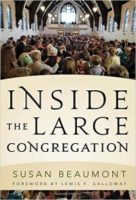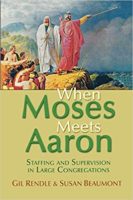Board leaders long for meaningful meetings. Instead, many participate in mind-numbing meetings that repetitively chase topics, with little forward momentum. Agendas are rigidly structured around the receipt of reports, with little work that actually impacts the future of the congregation. What would it take to foster more fruitful board conversations?
Recently, I observed a board conversation about declining worship attendance. The decline followed three years of slow, but steady growth. The topic appeared on the agenda as “worship attendance.” The conversation was introduced by the pastor as part of her regular monthly report. The pastor pointed out that every other indicator of church health looked positive; membership was up, the budget was growing, more people were serving in volunteer positions, and new programs were well attended. The pastor wondered aloud what the dip in attendance meant, and whether or not the dip was a foreboding indicator of future decline.
Immediately, the gathered leaders plunged into frenzied dialogue with a lot of “worrying about” attendance numbers. There was some brainstorming about cause, some speculation about how to solve “the problem”, and lots of worrying about long term budget implications. The conversation lasted twenty minutes, without any clear consensus as to whether the congregation actually had a problem, and no plan of approach as to what should happen next. Leaders agreed to watch the situation, and the conversation was tabled until the following month, where it was re-introduced again, with much the same outcome.
During my visit with the board, I asked the leaders if they would humor me in an experiment. The leaders agreed and I introduced the language of Richard Chait, et al., in their book Governance as Leadership. We discussed the differences between fiduciary, strategic and generative modes of governance, all of which must be nurtured within the life of a board. I introduced the following distinctions.
The fiduciary mode of governance focuses on the effective use of assets. It concerns itself with preventing theft, waste or misuse. It explores issues related to budgets, assets, compensation, facilities, fundraising and staff team performance. It considers the ethics of a situation, the safety of the constituency, the legality of things and appropriate boundary setting.
I asked the board to talk about the dip in worship attendance, purely through the lens of fiduciary governance. They talked about possible budgetary impact, and the long term correlation between attendance and giving patterns. They engaged in some worrying behaviors, but their overall conversation was directed towards specific asset areas. They asked themselves if giving patterns were historically correlated with attendance patterns. They wondered what a plateau in growth would mean for long overdue salary increases anticipated at the end of the year. They asked themselves what percentage of the operating budget was actually allocated to the production of the Sunday worship service. If people were changing the way that they participated in the life of the congregation (by worshiping less), should the assets devoted to worship attendance be re-allocated?
Next, I introduced the language of strategic governance. A board is operating in strategic mode when it explores the long-term impact on identity and future of the congregation. It examines the topic for its intersection with the questions: Who are we? Who are we here to serve? What is God calling us to do or become? Strategic governance builds authority, responsibility and accountability into the system by empowering others to act in pursuit of an agreed upon strategy.
I invited the board to wade into the conversation about attendance again, this time purely through the lens of strategic governance.
They had a rich conversation about the link between worship attendance and their identity as a disciple-making congregation. The wondered if less face time in worship actually reduced spiritual growth and relationship building within the congregation. They explored whether or not their mission suggested a particular sized worshiping community. They wondered aloud how they would know if they were being successful in worship, and whether or not worship attendance was an appropriate indicator of discipleship success.
The group decided that they needed better information to determine if the dip was problematic or not. Had some people dropped out of worship entirely, and if so, who were they? Or, was the dip reflective of a stable but growing body of worshippers that were attending with less frequency. The board decided to assign the research of these questions to the Director of Membership and asked for a more complete reporting, by demographic group, at the next scheduled meeting.
Finally, I introduced the mode of generative governance. This mode of governance seeks to unleash the power of creative thinking. Generative thinking invites meaning making about the knowledge, information and data. It involves re-framing problems/challenges so that the congregation can understand and approach them in new ways, by introducing paradigm shifts. Generative thinking typically requires noticing cues and clues, choosing and using new frames of reference, and intentionally constructing a dominant narrative.
Board leaders began their conversation again, this time adopting the generative lens. They began with open brainstorming about all of the challenges, problems and opportunities that might contribute to worship decline. They discussed the busy lifestyles of the congregants, the increase in competing activities on Sunday mornings, and the presence of a new mega-church across town. Someone suggested that members might be experiencing more authentic Sabbath by staying home on Sunday mornings. They talked about a recent article from ABP News/Herald on national trends in reported worship attendance, and they explored whether or not the article had anything to do with this congregation. They brainstormed possible ways to infuse more energy into the existing worship experience, and they suggested potential new worship venues to better meet the needs of congregants. They wondered what qualified as meaningful worship. Ultimately, they decided that they weren’t ready to create a narrative about worship attendance. They wanted to see more information first.
At the end of our experiment, leaders agreed that this conversation had been more meaningful and future focused than previous attempts. The board agreed that they wanted to delegate more of their fiduciary work, so that their future conversations could take on more generative and strategic overtones. They agreed that artificially separating the three modes of governance was an interesting experiment that they would adopt from time to time moving forward.
Most importantly, the board chair and pastor realized that they had important work to do in framing agenda items before bringing them to the board. The framing of an agenda item influences the mode of governance that the board assumes as it enters a conversation. The board chair decided that the agenda item for the following month’s meeting would read, “Changing patterns in worship attendance, by demographic group.”
And the conversation moved forward from there.
Susan Beaumont is a coach, educator, and consultant who has worked with hundreds of faith communities across the United States and Canada. Susan is known for working at the intersection of organizational health and spiritual vitality. She specializes in large church dynamics, staff team health, board development, and leadership during seasons of transition.
With both an M.B.A. and an M.Div., Susan blends business acumen with spiritual practice. She moves naturally between decision-making and discernment, connecting the soul of the leader with the soul of the institution. You can read more about her ministry at susanbeaumont.com.



